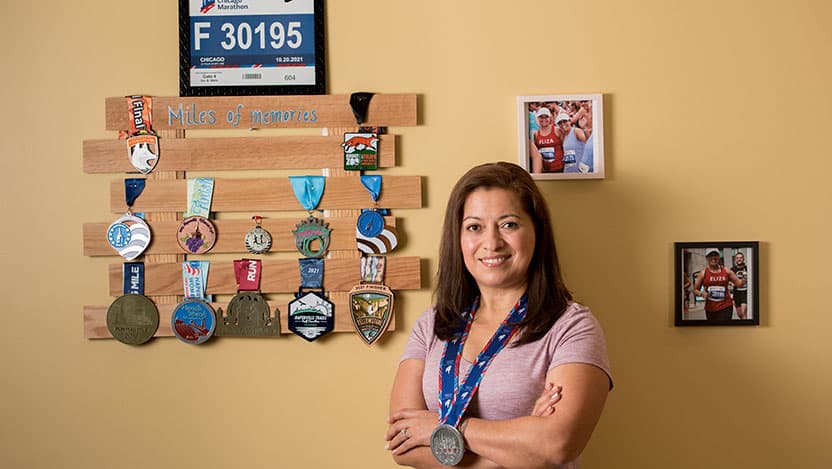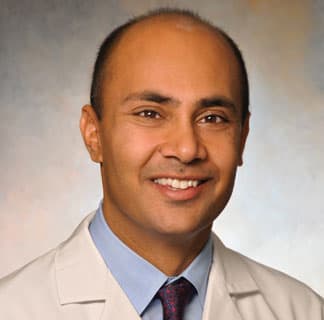Wheaton runner all smiles following complex vascular malformation surgery

Elizabeth Jimenez
Removing a large vascular growth from Elizabeth Jimenez’s face was one of the most difficult surgeries University of Chicago Medicine otolaryngologist Nishant Agrawal, MD, had ever done.
The surgery was so risky, and the condition was so rare, doctors from other hospitals referred her to UChicago Medicine because of its expertise in head and neck surgery.
It required removal of Jimenez’s arteriovenous vascular malformation (AVM), a tangled bundle of abnormal blood vessels located within a millimeter of her facial nerve and wrapped around her parotid gland, near her ear. The AVM was much larger than normal. If you got close to her, you could see and hear it pulsing underneath her skin, like a beating heart.
If something went wrong during surgery, Jimenez’s face could be permanently paralyzed or she could end up with a Bell’s palsy-like droop on one side. Not doing the surgery, however, could be life-threatening, as the AVM could burst open and hemorrhage.
Agrawal ordered multiple tests, studied her case for several weeks and consulted with the hospital’s neurointerventional radiology team before deciding he was ready to take on the challenge.
“It was tough. I was worried about it,” said Agrawal, Chief of Otolaryngology-Head and Neck Surgery at the University of Chicago Medicine. “It was an unusual, rare and very complex case and there was potential risk for damaging a nerve and losing a life-threatening amount of blood.”
As Jimenez was being wheeled into the operating room for the July 2018 surgery, she tearfully asked a nurse to pass along a message to Agrawal: “Tell him I want to smile again. I smile every day. It’s my favorite part of who I am. I can’t lose my smile.”
“Don’t worry,” the nurse told her. “You’re with one of the best head and neck doctors in the U.S.”
The 8-hour surgery was a success. Agrawal took out the parotid gland with the AVM without damaging the facial nerve.
The recovery process was difficult. For two months, Jimenez couldn’t move her forehead while she healed. Since laying down caused pain and pressure, she slept sitting up in a chair for 1½ months. She frequently had headaches and avoided mirrors, fearing her face might be disfigured. When she finally looked at herself, she smiled and her entire face moved perfectly.
“He gave me my smile back,” said the 44-year-old mother of two. “I am still smiling every day.”
“He gave me my smile back,” said the 44-year-old mother of two. “I am still smiling every day.”
Eventually, Agrawal gave Jimenez permission to resume running, allowing her to train for her first marathon. Between her recovery and COVID-19, she had to wait three years – until October 2021 – to run the Chicago Marathon. The night before the race, Agrawal called her to say good luck. She emailed him photos of herself after completing the 26.2-mile course.
“I thought about him when I was almost at the finish line and I started crying. I thought, after all I went through, ‘I did it!’” she said. “Dr. Agrawal did so much for me and whenever I needed something, he was there. I don’t know how he makes time to respond to my emails or calls so fast. I don’t have any way to repay him, so I just pray for him and hope for the best for him, and hope that he’s happy.”
Vascular malformations are very rare. They’re usually caused by a trauma or injury that creates abnormal blood vessels. Jimenez’s, however, appears to have formed on its own. There are different types of vascular malformations, not all of which require surgery, but arteriovenous malformations, like Jimenez’s, can be dangerous and are usually surgically removed.
Jimenez, who grew up in Mexico, said the dizziness and pulsating sounds began many years ago, but the doctors there didn’t think the symptoms were any cause for alarm. By 2018, the pulsating noise was interrupting her sleep. Her primary care doctor noticed that one side of her face was bigger than the other and recommended she see a specialist. After visiting other hospitals, she eventually found Agrawal.
Jimenez returned to her full-time job doing IT in St. Charles. Her prognosis is very good, Agrawal said.
“That surgery changed my life.” Jimenez said. “Every morning when I go to work, and I see the sunrise, I thank God I have this opportunity. I can enjoy my life. I see life as beautiful now. Maybe I needed all of this to happen to see life the way I do. And I know Dr. Agrawal is always there for me.”


Nishant Agrawal, MD
Nishant Agrawal, MD, specializes in treating benign and malignant tumors of the head and neck. He serves as section chief of otolaryngology - head and neck surgery as well as director of head and neck surgical oncology.
Read Dr. Agrawal's physician profile